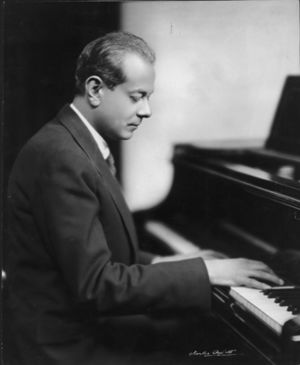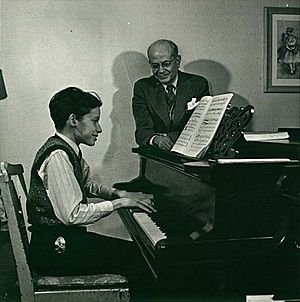Alberto Guerrero facts for kids
Quick facts for kids
Alberto García
|
|
|---|---|
 |
|
| Background information | |
| Birth name | Antonio Alberto García Guerrero |
| Born | February 6, 1886 La Serena, Chile |
| Died | November 7, 1959 (aged 73) Toronto, Ontario, Canada |
Antonio Alberto García Guerrero (born February 6, 1886 – died November 7, 1959) was a talented musician from Chile. He was a composer, a pianist, and a teacher. He is best known for being the teacher of the famous Canadian pianist Glenn Gould. But Alberto García also helped many other musicians over the years. He taught for a long time at the Toronto Conservatory of Music.
Contents
Who Was Alberto García?
Alberto García was born in La Serena, Chile. He first learned to play the piano from his mother and his older brother, Daniel. After that, he mostly taught himself. In the early 1890s, his family moved to Santiago. There, he joined a group of artists and thinkers called "Los Diez," which means "The Ten."
His Early Music Career
Alberto García was a very creative composer. He was also a skilled concert pianist. He helped bring new ideas to music in Chile. His brother, Eduardo, became a music critic. Alberto also wrote articles and reviews for a newspaper called El diario ilustrado. In 1915, he wrote a book about music theory, but it is now lost.
García introduced people in Chile to new kinds of music. He played works by famous composers like Debussy, Ravel, and Schoenberg. He also started and led Santiago's first symphony orchestra. In 1917, he helped create the Sociedad Bach, a group focused on the music of Bach.
Moving to Canada
In 1918, Alberto García went to New York City for his honeymoon. There, he met the Hambourg family. They invited him to teach at their new music school in Toronto, Canada. García accepted the offer. He moved to Canada with his wife and daughter the next year.
In Toronto, García played with the Hambourg Trio for a few years. He started to focus more on teaching piano and how to play it well. He also learned new pieces to perform, from old composers like Purcell to more modern ones. He became one of Canada's busiest pianists.
Radio and Recitals
Starting in the mid-1920s, García played regular concerts on the radio. This was a very new and exciting thing to do at the time. He continued these radio performances until the early 1950s. From 1932 to 1937, he also started his own series of solo concerts. Each season, he would play four or five concerts. He often played pieces that were not well-known. These included works by Bach, Scarlatti, Haydn, and Mozart.
He also played pieces by Spanish composers from the 1700s and French composers from the 1900s. Some of the Bach pieces he played were the complete inventions and sinfonias. He also played the Goldberg Variations. These pieces later became very popular because of his student, Glenn Gould. García also played in small music groups with other musicians. For more than ten years, he was part of a group called the Five Piano Ensemble.
Teaching at the Conservatory
In 1922, García left the Hambourg Conservatory. He joined the Toronto Conservatory of Music, which is now called the Royal Conservatory of Music. He stayed there until he passed away in Toronto in 1959. He became known as one of Canada's most important music teachers.
Alberto García was known for being a quiet and focused person. He helped many Canadian musicians become famous in the late 1900s. He had a big impact on Glenn Gould's piano playing and ideas. García taught Gould for ten years. Even though Gould later said he taught himself, García's influence was very important. García was also known for being very smart. He loved talking about painting, poetry, and philosophy. Composer R. Murray Schafer said that García helped students think about ideas beyond just music. Schafer wrote a piece of music called In Memoriam Alberto Guerrero after his teacher died.
What Music Did He Write?
Alberto García was known as a composer in Santiago. He wrote music for piano and for small groups of instruments. He also wrote music for four or five operettas and zarzuelas (a type of Spanish musical play). These were performed in Chile between 1908 and 1915, but they are now lost.
After moving to Canada, García focused more on teaching. However, he did publish two piano pieces in 1937: Tango and Southern Seas. He also worked with his wife, Myrtle Rose Guerrero, to write a two-volume book called The New Approach to the Piano (1935–36).
His Students
Alberto García was a very important person in music in Santiago and later at the Toronto Conservatory of Music. He taught many students who went on to become important musicians. They helped shape the music scene in Chile, Canada, and other places. Here is a list of some of his students:
- William Aide
- John Beckwith
- Joan Bell
- Helmut Blume
- Gwendolyn Duchemin
- Ray Dudley
- Jeanette Fujarczuk
- Dorothy Sandler Glick
- Glenn Gould
- Myrtle Rose Guerrero (2nd wife)
- Stuart Hamilton
- Paul Helmer
- Horace Lapp
- Edward Laufer
- Gordana Lazarevich
- Pierrette LePage
- Jean Lyons
- Edward Magee
- Ursula Malkin
- Bruce Mather
- John McIntyre
- Gordon McLean
- Gerald Moore
- Oscar Morawetz
- Laurence Morton
- Arthur Ozolins
- George Ross
- Domingo Santa Cruz Wilson
- R. Murray Schafer
- Oleg Telizyn
- Malcolm Troup
- Neil Van Allen
- Ruth Watson Henderson
- Grace Irene Hunt McDonald
- Gayle Sharlene Brown
Recordings
You can hear some of Glenn Gould's early recordings that were made while he was studying with García.
- Glenn Gould: His First Recordings (1947–1952). Video Artists International 1198 (2001).
See also
 In Spanish: Alberto Guerrero para niños
In Spanish: Alberto Guerrero para niños


